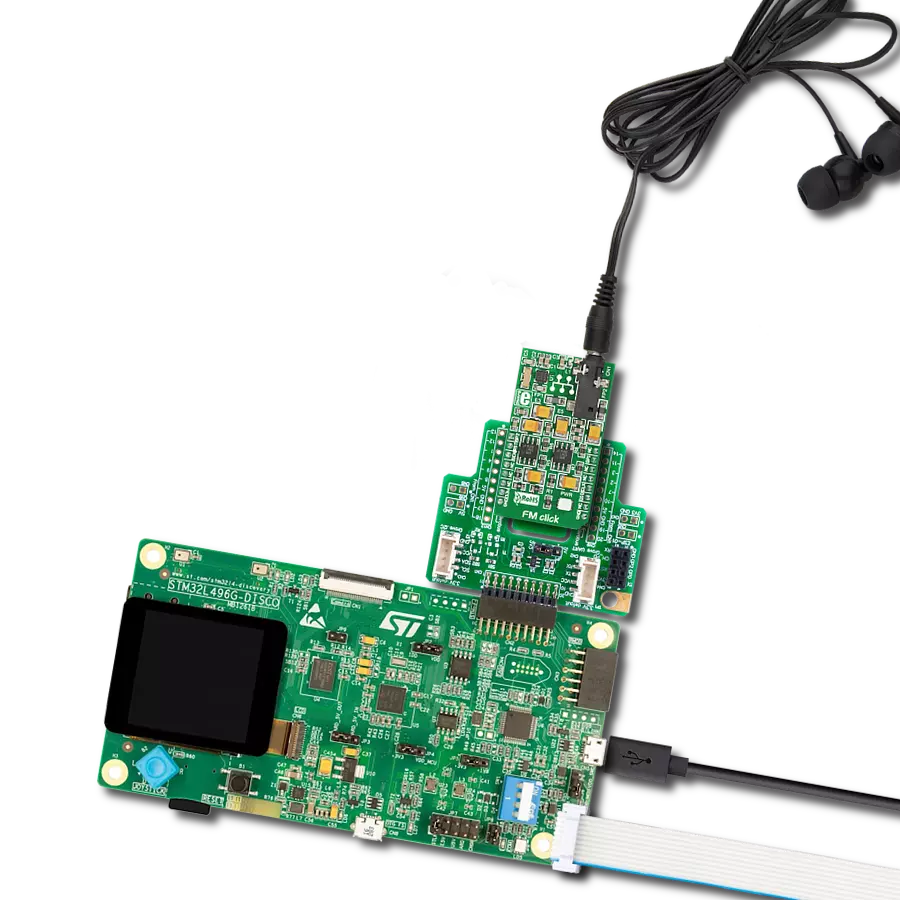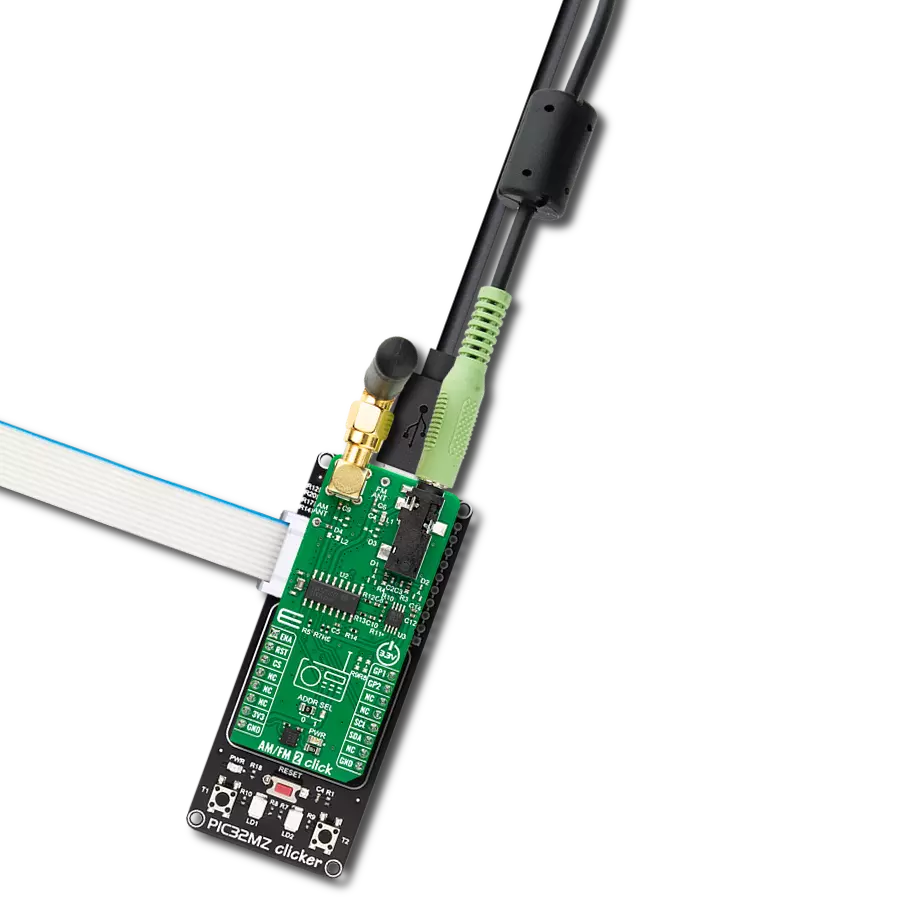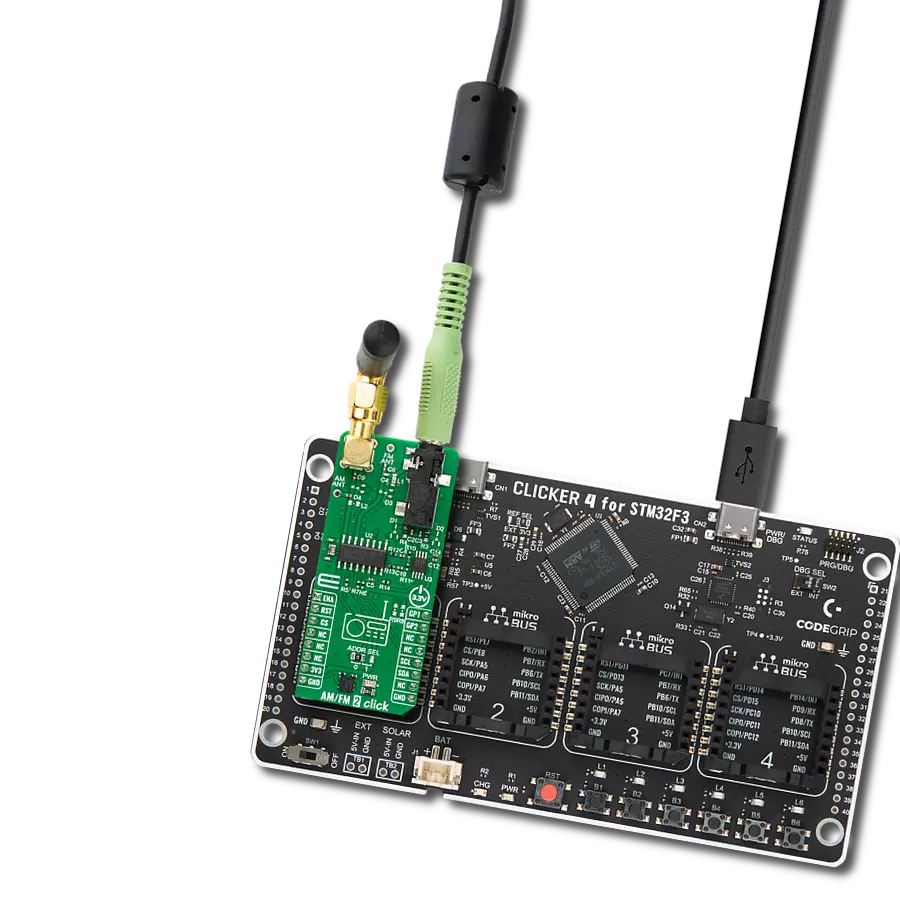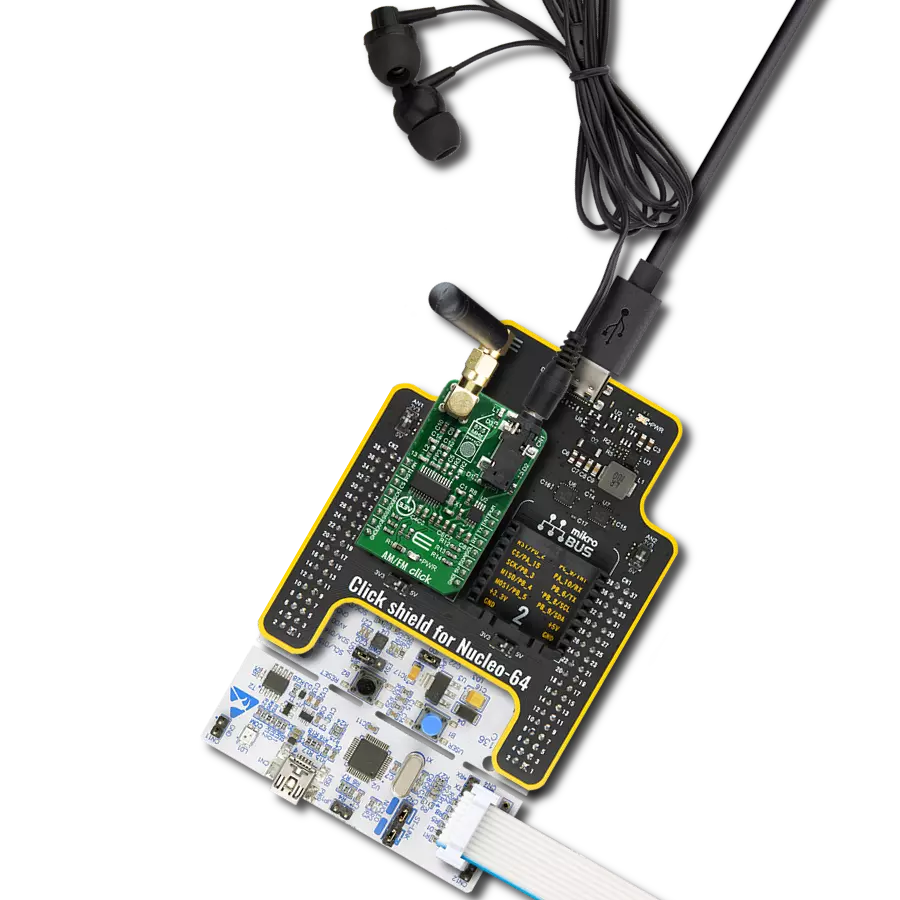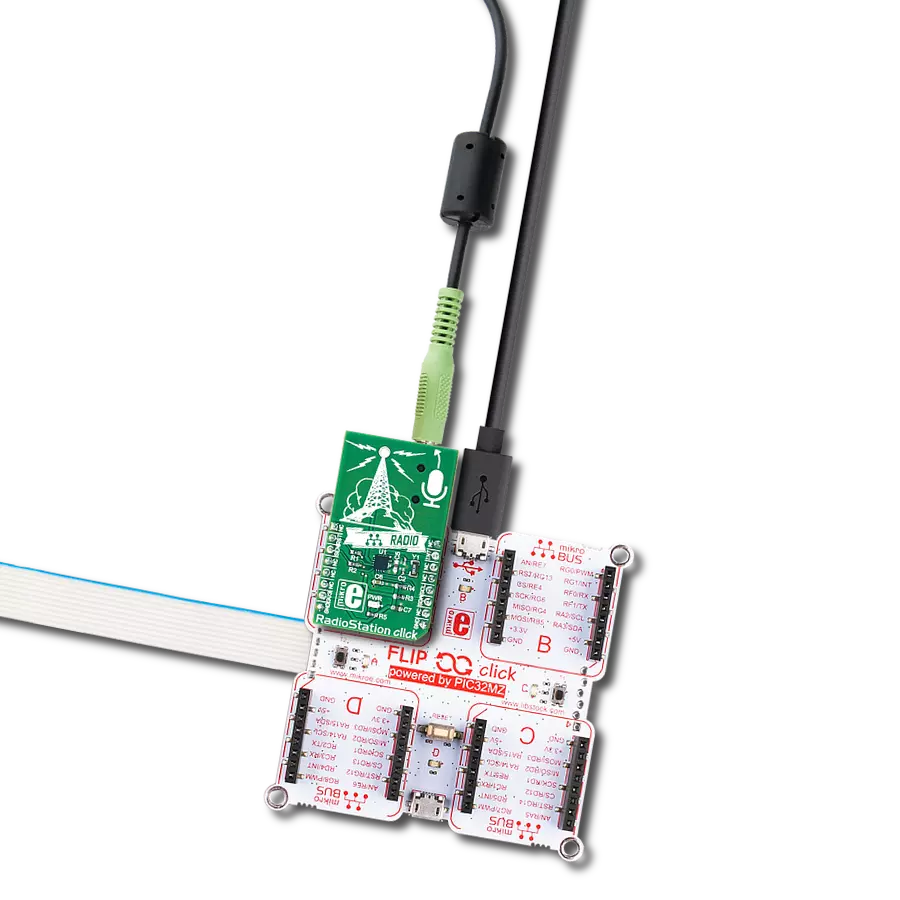Immerse yourself in a symphony of sound as our radio receiver opens up the airwaves, bringing the rich tapestry of AM and FM music directly to your ears
A
A
Hardware Overview
How does it work?
AM/FM Click is based on the Si4731, a digital CMOS AM/FM radio receiver IC that integrates the complete broadcast tuner and receiver function from antenna input to digital audio output from Silicon Labs. The audio signal from the output of the Si4731 is brought to a mini 3.5 female jack on board over the LM4910 - an output capacitor-less stereo 35mW headphone amplifier from Texas Instruments. That way, it is ensured that the user can plug in the headphones directly into the Click board™ without the need for any external amplifier. The Si4731 IC The device leverages the Silicon Labs broadcast-proven digital low-IF architecture, enabling a cost-effective digital audio platform for consumer electronic applications with high TDMA noise immunity, superior radio performance, and high fidelity audio power amplification. The audio signal is processed to
have the optimal dynamic qualities. The integrated DSP also handles the signal's stereo MPX encoding and FM modulation. The low-level digital intermediate frequency (IF) signal is filtered out and sent to the outputs, amplified, filtered, and digitized with high-resolution analog-to-digital converters (ADCs). This advanced architecture allows the Si4731- to perform channel selection, FM demodulation, and stereo audio processing to achieve superior performance compared to traditional analog architectures. The Click is designed for communication over the I2C/2-wire control interface. When selecting 2-wire mode, the SCLK pin should stay at a HIGH logic level during the rising edge on the RST pin and stay HIGH until after the first start condition. Also, a start condition must not occur within 300nS before the rising edge on the RST pin. The 2-wire
bus mode uses only the SCL and SDA pins for communication. The Si4731 IC has the capability of the received signal measurement. The antenna used to broadcast the signal can also be used to accept the incoming signal sent by the receiving device. Although it can be used both to receive and transmit signals, the antenna can't operate in both modes simultaneously. This feature can be useful when calibrating the transmission power of the click board. This Click board™ can be operated only with a 3.3V logic voltage level. The board must perform appropriate logic voltage level conversion before using MCUs with different logic levels. Also, it comes equipped with a library containing functions and an example code that can be used as a reference for further development.
Features overview
Development board
Clicker 2 for Kinetis is a compact starter development board that brings the flexibility of add-on Click boards™ to your favorite microcontroller, making it a perfect starter kit for implementing your ideas. It comes with an onboard 32-bit ARM Cortex-M4F microcontroller, the MK64FN1M0VDC12 from NXP Semiconductors, two mikroBUS™ sockets for Click board™ connectivity, a USB connector, LED indicators, buttons, a JTAG programmer connector, and two 26-pin headers for interfacing with external electronics. Its compact design with clear and easily recognizable silkscreen markings allows you to build gadgets with unique functionalities and
features quickly. Each part of the Clicker 2 for Kinetis development kit contains the components necessary for the most efficient operation of the same board. In addition to the possibility of choosing the Clicker 2 for Kinetis programming method, using a USB HID mikroBootloader or an external mikroProg connector for Kinetis programmer, the Clicker 2 board also includes a clean and regulated power supply module for the development kit. It provides two ways of board-powering; through the USB Micro-B cable, where onboard voltage regulators provide the appropriate voltage levels to each component on the board, or
using a Li-Polymer battery via an onboard battery connector. All communication methods that mikroBUS™ itself supports are on this board, including the well-established mikroBUS™ socket, reset button, and several user-configurable buttons and LED indicators. Clicker 2 for Kinetis is an integral part of the Mikroe ecosystem, allowing you to create a new application in minutes. Natively supported by Mikroe software tools, it covers many aspects of prototyping thanks to a considerable number of different Click boards™ (over a thousand boards), the number of which is growing every day.
Microcontroller Overview
MCU Card / MCU
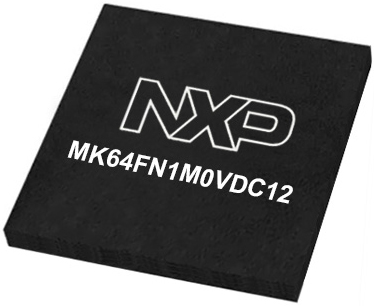
Architecture
ARM Cortex-M4
MCU Memory (KB)
1024
Silicon Vendor
NXP
Pin count
121
RAM (Bytes)
262144
You complete me!
Accessories
These standard small stereo earphones offer a high-quality listening experience with their top-notch stereo cable and connector. Designed for universal compatibility, they effortlessly connect to all MIKROE mikromedia and multimedia boards, making them an ideal choice for your electronic projects. With a rated power of 100mW, the earphones provide crisp audio across a broad frequency range from 20Hz to 20kHz. They boast a sensitivity of 100 ± 5dB and an impedance of 32Ω ± 15%, ensuring optimal sound quality. The Φ15mm speaker delivers clear and immersive audio. Cost-effective and versatile, these earphones are perfect for testing your prototype devices, offering an affordable and reliable audio solution to complement your projects.
Used MCU Pins
mikroBUS™ mapper
Take a closer look
Click board™ Schematic

Step by step
Project assembly
Software Support
Library Description
This library contains API for AM/FM Click driver.
Key functions:
amfm_tune_up- This function increments current frequency for 10 KHzamfm_set_volume- This function sets volume level in range: 0 - 63amfm_get_stc-This function checks STC bit state
Open Source
Code example
The complete application code and a ready-to-use project are available through the NECTO Studio Package Manager for direct installation in the NECTO Studio. The application code can also be found on the MIKROE GitHub account.
/*!
* \file
* \brief AmFm Click example
*
* # Description
* This app simulate RADIO RECEIVER.
*
* The demo application is composed of two sections :
*
* ## Application Init
* Initializes device.
*
* ## Application Task
* Several additional functions are executed and printed over the terminal.
*
* \author MikroE Team
*
*/
// ------------------------------------------------------------------- INCLUDES
#include "board.h"
#include "log.h"
#include "amfm.h"
// ------------------------------------------------------------------ VARIABLES
static amfm_t amfm;
static log_t logger;
float aux;
uint8_t volume = 0x3F;
uint8_t mute_flag = 0;
uint8_t status;
uint16_t station_1 = 0;
uint16_t station_2 = 0;
uint16_t station_3 = 0;
uint16_t station_4 = 0;
uint16_t station_5 = 0;
uint16_t station_frequency = 0;
uint8_t memory = 0;
// ------------------------------------------------------- ADDITIONAL FUNCTIONS
void amfm_case_memorize ( )
{
switch ( memory )
{
case 0 :
{
station_1 = station_frequency;
memory += 1;
log_printf( &logger, "> > > station 1 memorized\r\n" );
break;
}
case 1 :
{
station_2 = station_frequency;
memory += 1;
log_printf( &logger, "> > > station 2 memorized\r\n" );
break;
}
case 2 :
{
station_3 = station_frequency;
memory += 1;
log_printf( &logger, "> > > station 3 memorized\r\n" );
break;
}
case 3 :
{
station_4 = station_frequency;
memory += 1;
log_printf( &logger, "> > > station 4 memorized\r\n" );
break;
}
case 4 :
{
station_5 = station_frequency;
memory = 0;
log_printf( &logger, "> > > station 5 memorized\r\n" );
break;
}
default :
{
break;
}
}
log_printf( &logger, "-----------------------------------------\r\n" );
}
void amfm_case_station_1 ( amfm_t *ctx )
{
log_printf( &logger, "> > > tune station 1 \r\n" );
amfm_tune_frequency( ctx, station_1 );
log_printf( &logger, "> > > tune done \r\n" );
aux = station_1 / 100.0;
log_printf( &logger, "> > > frequency: %f MHz \r\n", aux );
log_printf( &logger, "-----------------------------------------\r\n" );
}
void amfm_case_station_2 ( amfm_t *ctx )
{
log_printf( &logger, "> > > tune station 2 \r\n" );
amfm_tune_frequency( ctx, station_2 );
log_printf( &logger, "> > > tune done \r\n" );
aux = station_2 / 100.0;
log_printf( &logger, "> > > frequency: %f MHz \r\n", aux );
log_printf( &logger, "-----------------------------------------\r\n" );
}
void amfm_case_station_3 ( amfm_t *ctx )
{
log_printf( &logger, "> > > tune station 3 \r\n" );
amfm_tune_frequency( ctx, station_3 );
log_printf( &logger, "> > > tune done \r\n" );
aux = station_3 / 100.0;
log_printf( &logger, "> > > frequency: %f MHz \r\n", aux );
log_printf( &logger, "-----------------------------------------\r\n" );
}
void amfm_case_station_4 ( amfm_t *ctx )
{
log_printf( &logger, "> > > tune station 4 \r\n" );
amfm_tune_frequency( ctx, station_4 );
log_printf( &logger, "> > > tune done \r\n" );
aux = station_4 / 100.0;
log_printf( &logger, "> > > frequency: %f MHz \r\n", aux );
log_printf( &logger, "-----------------------------------------\r\n" );
}
void amfm_case_station_5 ( amfm_t *ctx )
{
log_printf( &logger, "> > > tune station 5 \r\n" );
amfm_tune_frequency( ctx, station_5 );
log_printf( &logger, "> > > tune done \r\n" );
aux = station_5 / 100.0;
log_printf( &logger, "> > > frequency: %f MHz \r\n", aux );
log_printf( &logger, "-----------------------------------------\r\n" );
}
void amfm_case_seek ( amfm_t *ctx )
{
log_printf( &logger, "> > > seek \r\n" );
amfm_seek( ctx );
log_printf( &logger, "> > > seek done \r\n" );
station_frequency = amfm_get_channel( ctx );
aux = station_frequency / 100.0;
log_printf( &logger, "> > > frequency: %f MHz \r\n", aux );
log_printf( &logger, "-----------------------------------------\r\n" );
}
void amfm_case_plus ( amfm_t *ctx )
{
if ( volume < 63 )
{
volume += 1;
amfm_set_volume( ctx, volume );
log_printf( &logger, "> > > volume: %u \r\n", volume );
}
else
{
log_printf( &logger, "> > > volume: MAX \r\n" );
}
log_printf( &logger, "-----------------------------------------\r\n" );
}
void amfm_case_minus ( amfm_t *ctx )
{
if ( volume > 0 )
{
volume -= 1;
amfm_set_volume( ctx, volume );
log_printf( &logger, "> > > volume: %u \r\n", volume );
}
else
{
log_printf( &logger, "> > > volume: MIN \r\n" );
}
log_printf( &logger, "-----------------------------------------\r\n" );
}
void amfm_case_mute ( amfm_t *ctx )
{
if ( 0 == mute_flag )
{
amfm_mute( ctx );
log_printf( &logger, "> > > mute ON \r\n" );
mute_flag = 1;
}
else
{
amfm_unmute( ctx );
log_printf( &logger, "> > > mute OFF \r\n" );
mute_flag = 0;
}
log_printf( &logger, "-----------------------------------------\r\n" );
}
void amfm_case_tune_up ( amfm_t *ctx )
{
amfm_tune_up( ctx );
station_frequency = amfm_get_channel( ctx );
aux = station_frequency / 100.0;
log_printf( &logger, "> > > frequency: %f MHz \r\n", aux );
log_printf( &logger, "-----------------------------------------\r\n" );
}
void amfm_case_tune_down ( amfm_t *ctx )
{
amfm_tune_down( ctx );
station_frequency = amfm_get_channel( ctx );
aux = station_frequency / 100.0;
log_printf( &logger, "> > > frequency: %f MHz \r\n", aux );
log_printf( &logger, "-----------------------------------------\r\n" );
}
// ------------------------------------------------------ APPLICATION FUNCTIONS
void application_init ( void )
{
log_cfg_t log_cfg;
amfm_cfg_t cfg;
/**
* Logger initialization.
* Default baud rate: 115200
* Default log level: LOG_LEVEL_DEBUG
* @note If USB_UART_RX and USB_UART_TX
* are defined as HAL_PIN_NC, you will
* need to define them manually for log to work.
* See @b LOG_MAP_USB_UART macro definition for detailed explanation.
*/
LOG_MAP_USB_UART( log_cfg );
log_init( &logger, &log_cfg );
log_info( &logger, "---- Application Init ----" );
// Click initialization.
amfm_cfg_setup( &cfg );
AMFM_MAP_MIKROBUS( cfg, MIKROBUS_1 );
amfm_init( &amfm, &cfg );
Delay_ms ( 100 );
status = amfm_init_device( &amfm );
if ( 0 == status )
{
log_printf( &logger, "> > > app init done < < <\r\n" );
}
else if ( 1 == status )
{
log_printf( &logger, "> > > timeout < < <\r\n" );
}
Delay_ms ( 1000 );
amfm_case_seek( &amfm );
amfm_case_memorize( );
Delay_ms ( 1000 );
amfm_case_seek( &amfm );
amfm_case_memorize( );
Delay_ms ( 1000 );
amfm_case_seek( &amfm );
amfm_case_memorize( );
Delay_ms ( 1000 );
amfm_case_seek( &amfm );
amfm_case_memorize( );
Delay_ms ( 1000 );
amfm_case_seek( &amfm );
amfm_case_memorize( );
Delay_ms ( 1000 );
amfm_case_plus( &amfm );
Delay_ms ( 1000 );
}
void application_task ( void )
{
amfm_case_station_1( &amfm );
// 10 seconds delay
Delay_ms ( 1000 );
Delay_ms ( 1000 );
Delay_ms ( 1000 );
Delay_ms ( 1000 );
Delay_ms ( 1000 );
Delay_ms ( 1000 );
Delay_ms ( 1000 );
Delay_ms ( 1000 );
Delay_ms ( 1000 );
Delay_ms ( 1000 );
amfm_case_station_2( &amfm );
// 10 seconds delay
Delay_ms ( 1000 );
Delay_ms ( 1000 );
Delay_ms ( 1000 );
Delay_ms ( 1000 );
Delay_ms ( 1000 );
Delay_ms ( 1000 );
Delay_ms ( 1000 );
Delay_ms ( 1000 );
Delay_ms ( 1000 );
Delay_ms ( 1000 );
amfm_case_station_3( &amfm );
// 10 seconds delay
Delay_ms ( 1000 );
Delay_ms ( 1000 );
Delay_ms ( 1000 );
Delay_ms ( 1000 );
Delay_ms ( 1000 );
Delay_ms ( 1000 );
Delay_ms ( 1000 );
Delay_ms ( 1000 );
Delay_ms ( 1000 );
Delay_ms ( 1000 );
amfm_case_station_4( &amfm );
// 10 seconds delay
Delay_ms ( 1000 );
Delay_ms ( 1000 );
Delay_ms ( 1000 );
Delay_ms ( 1000 );
Delay_ms ( 1000 );
Delay_ms ( 1000 );
Delay_ms ( 1000 );
Delay_ms ( 1000 );
Delay_ms ( 1000 );
Delay_ms ( 1000 );
amfm_case_station_5( &amfm );
// 10 seconds delay
Delay_ms ( 1000 );
Delay_ms ( 1000 );
Delay_ms ( 1000 );
Delay_ms ( 1000 );
Delay_ms ( 1000 );
Delay_ms ( 1000 );
Delay_ms ( 1000 );
Delay_ms ( 1000 );
Delay_ms ( 1000 );
Delay_ms ( 1000 );
}
int main ( void )
{
/* Do not remove this line or clock might not be set correctly. */
#ifdef PREINIT_SUPPORTED
preinit();
#endif
application_init( );
for ( ; ; )
{
application_task( );
}
return 0;
}
// ------------------------------------------------------------------------ END


























